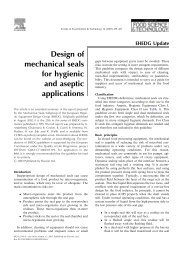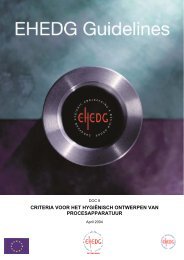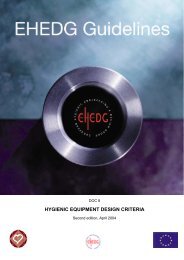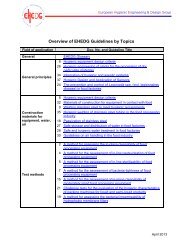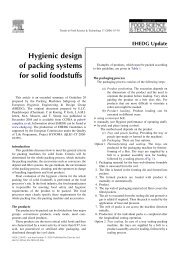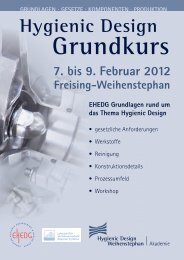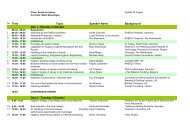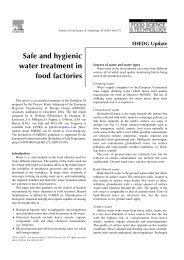Yearbook 2013/2014 - ehedg
Yearbook 2013/2014 - ehedg
Yearbook 2013/2014 - ehedg
You also want an ePaper? Increase the reach of your titles
YUMPU automatically turns print PDFs into web optimized ePapers that Google loves.
104 Material and design optimisation calculated by EHEDG: Tubing systems<br />
After additional production steps, such as grinding,<br />
annealing and leveling, the tubing must undergo eddy<br />
current testing in order to ensure the quality of the longitudinal<br />
weld seam.<br />
3. The third method plays a role in refinery and power<br />
plant technologies, which use tubing with wall thicknesses<br />
exceeding 16 mm. Hot rolled steel is typically the<br />
primary material. It is formed into tubing with the aid of<br />
presses that exert hundreds of tons of pressure onto<br />
the material and then longitudinally seam welded.<br />
The mastery and exploitation of such manufacturing<br />
processes means achieving optimal material properties. The<br />
suitability of the material for further processing is equally<br />
important. Analysis is made possible by the countless material<br />
and surface testing procedures currently available. The most<br />
well-known method is the measurement of Ra values. The<br />
results of surface profile measurements, however, are limited<br />
in validity because they do not provide information about<br />
the microstructure. Additional inspections are necessary for<br />
proving suitability of the tubing, for example, welding tests,<br />
electrolytic polishing tests and microscopy.<br />
Important: Materials selection<br />
The right selection of suitable materials determines, among<br />
other things, cleaning qualities and system life. Today, there<br />
are a multitude of alloys on the market that possess the<br />
necessary stable properties to stand up against different<br />
types of corrosion. In order to fully utilise their properties,<br />
however, they must be properly processed. The application<br />
and its particular influencing factors, such as medium,<br />
concentration, time and temperature determine the selection<br />
of materials and surfaces.<br />
Figure 2. Beyond standards: Example of a customised branch<br />
solution.<br />
Manifolds: Dead space minimisation is the<br />
objective<br />
Figure 3 shows a manifold with attached valve, for example,<br />
for dosing an additive into a base fluid. Conspicuous here is<br />
the short distance between the central tubing and the valve<br />
base plate. As a result, a tiny dead space occurs when the<br />
valve is closed. In comparison to conventional construction<br />
with T-pieces, the potential dead space volumes are reduced<br />
by approximately 38%; at the same time, the component is<br />
clearly more compact (Figure 4).<br />
Branch conduits: Know-how is in the details<br />
The production of geometrically simple and frequently<br />
used components, such as branches, demonstrates the<br />
complexity of implementing EHEDG guidelines. This<br />
begins with the selection of materials. This is the only<br />
way that optimal welding can be ensured. Furthermore,<br />
the processing methods must be adjusted to the future<br />
application.<br />
Different techniques (boring, saddle, and collaring<br />
methods) are available for the processing of T-pieces, each<br />
of which have their merits, but also their application limits.<br />
Dockweiler uses the collaring method for branch conduits<br />
with a diameter of 19.05 to 168.30 mm and also produces<br />
special T-pieces, for example, with inclined or eccentric<br />
outlets (Figure 2). The advantages are exact geometry and<br />
complete drainability of the production system. Dockweiler<br />
solely uses the Wolfram Inert Gas Process (WIG) orbital<br />
welding method for producing components. Validated<br />
documentation is available for all welding seams and<br />
surfaces; depending on requirements, components are<br />
electropolished after production. If desired by the customer,<br />
pressure calculations or X-ray testing can be conducted for<br />
critical components.<br />
Figure 3. The minimisation of dead space is an important design<br />
objective for many EHEDG-compliant tubing components.<br />
Figure 4. Compact and hygienic: Short branch with valve base plate.



